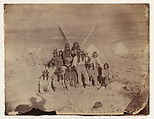Shoshone
Timothy H. O'Sullivan American, born Ireland
Not on view
The homeland of the Shoshoni covered large tracts of the Great Basin--portions of Nevada, Oregon, Idaho, and Utah. O'Sullivan photographed in their territory in 1867-69 and 1872 with Clarence King, and in 1871 with Lieutenant George Wheeler. Many of the men in the photograph are wearing U. S. Army hats and shirts, paraphernalia probably acquired through barter at the Army's trading posts.
When O'Sullivan made the picture, the delicate ecology of the Shoshoni's food sources (buffalo, small game, roots, berries, and grass seed) had been virtually destroyed over the preceding thirty years by the heedless practices of emigrant white settlers. The resulting degradation and the marauding, murderous retaliation of the Shoshoni and associated tribes became known as the "Indian question," which the U.S. government attempted to resolve through legislation, the establishment of reservations, and, on occasion, slaughter.
As an exploratory visitor rather than an exploitative settler, O'Sullivan met little hostility from Native Americans. If some of his subjects were reluctant to pose for the "shadow-catcher," the thirteen Shoshoni depicted here seem resolute and patient. Expressed as a pyramid, the group's corporate solidarity appears as permanent as an ancient cairn, in contrast to the American and expeditionary flags, tents, and distant plain which, through the photographer's choice, are rendered as flat and insubstantial as his own shadow.
Due to rights restrictions, this image cannot be enlarged, viewed at full screen, or downloaded.

